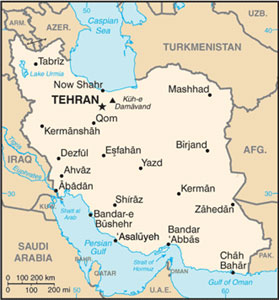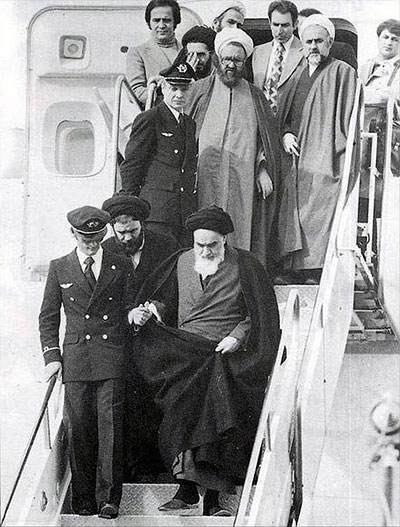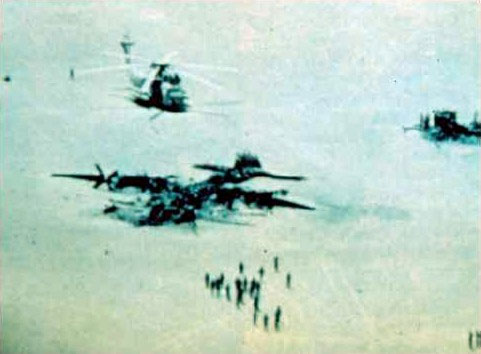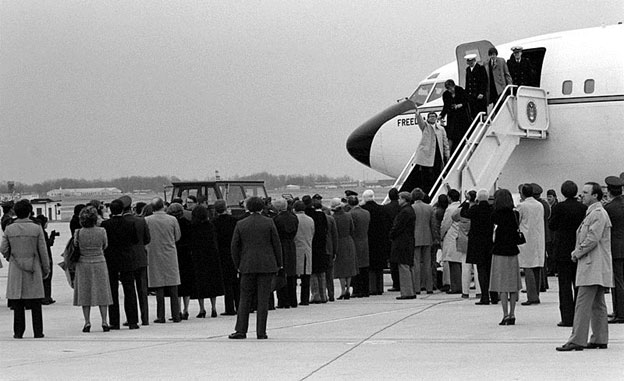
Source: Map template IR, The World Fact Book
Iran

Source: Map template IR, The World Fact Book
President Jimmy Carter faced another crisis in the Middle East during the last year of his presidency, the Iran Hostage Crisis, in which more than 60 American hostages were taken from the U.S. Embassy in Tehran, Iran. The events leading up to this crisis started decades before the hostages were taken in 1979. Read about the background between the United States and Iran below.
| Oil | Change in Government | The Iranian Revolution |
|
|
|
Ayatollah Khomeini returns to Iran after 14 Years in Exile (1979)

Source: Imam Khomeini in Mehrabad, Sajed, Wikipedia
Quick Reflection - Why was the change in government in Iran important to the United States?

The Shah of Iran and President Jimmy Carter

Source: Shah and Carter, Iran Persian Gulf Forever, Wikipedia
Several months after fleeing to Egypt, the Shah was diagnosed with cancer. He was in need of treatment and requested permission to come to the United States. Reluctantly, President Carter allowed the Shah to enter the United States, despite fearing that Americans in Iran might be attacked.
Carter’s fears became reality on November 4, 1979, when a group of Iranian students took over the U.S. Embassy in Tehran, taking more than 60 Americans hostage. The students demanded that the United States return the Shah to Iran for trial before the hostages would be released.
On November 11th, Carter placed an embargo on Iranian oil and froze the financial assets of Iran in the United States. In response, Khomeini freed African Americans and women hostages, citing that these Americans had already been oppressed by the United States. The remaining hostages remained in captivity while the United States and Iran failed at negotiation attempts.
The Wreckage of Operation Desert One

Source: Eagle Claw wrecks at Desert One April 1980, Cabotfor, Wikipedia
After negotiations failed, Carter decided to use a military operation to rescue the hostages. On April 24, 1980, the plan to rescue the hostages, Operation Desert One, was to be executed, but President Carter had to call off the mission. Several of the helicopters malfunctioned and one helicopter crashed into a plane while taking off. Five people in the airplane and three Marines in the helicopter were killed. This failed mission placed a blemish on the Carter Administration and halted negotiations.
Americans were growing weary of the crisis, and tempers flared as demonstrations and protests took place in Washington, D.C.

Source: Men bowing in prayer at an Iran Hostage Crisis Student demonstration, Washington D.C., Marion Trisoko, The Library of Congress
Iran Hostage Crisis student demonstration, Washington D.C., Marian Trisoko, The Library of Congress
The hostage crisis continued as Carter was running for reelection against Ronald Reagan, who used Carter’s failure to fuel his campaign for the presidency. By September of 1980, Khomeini grew tired of the economic sanctions that the United States placed on the Iranian economy. Ronald Reagan won his election and took office as President of the United States on January 20, 1981. The hostages were released immediately after Reagan took office.
The Iran Hostages Return to the United States

Source: Iran hostages return, Don Koralewski, Wikimedia
Click here to listen to the audio response to the release of the hostages.
![]() American Hostages Released from Iran Audio
American Hostages Released from Iran Audio
Quick Reflection - Why do you think the hostages were released the minute that Reagan took office?

![]() Think about what you have learned about the Iran Hostage Crisis. Which of the following characteristics of a world power did the United States illustrate during the crisis? Click on the correct attribute(s).
Think about what you have learned about the Iran Hostage Crisis. Which of the following characteristics of a world power did the United States illustrate during the crisis? Click on the correct attribute(s).
The Camp David Peace Accords and the Iran Hostage Crisis are examples of how the United States’ role as a world power can change within a matter of years. President Carter used the influence of the United States to accomplish important steps toward peace in the Middle East between two countries that had been at war with each other for decades. During the same administration, he experienced multiple failures over more than a year before finally succeeding in freeing the American hostages who were being held by Iranians.